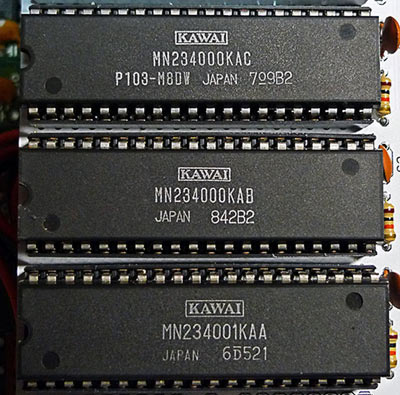ROM Building Software
Kawai R-Series Sound ROM Encoder/Decoder Tools v1.00
Automatically create Kawai R50/R50E/R100 compatible sound ROMs; no special preparation or format knowledge needed. Simply supply normal WAV files and the tool will convert them to the proper format/layout required for Kawai before generating a complete, ready-to-burn EPROM binary.
ROMs can also be decoded, so users can dump any R-series sound ROMs to WAV and use the sounds in other samplers and drum machines, or mix-and-match them to create hybrid sound ROMS for their own R50/R50E/R100!
Note to Other Devs: Includes the Kawai LUTs needed for working with the Kawai 12-bit format. Open knowledge forever!

Available Kawai R-Series ROMs
All three Kawai R100/R50E/R50 factory ROMs, and multiple high-quality custom authored ROMs have been made freely available for download in our Kawai R-Series Sound ROM Archive.
Currently Available Sound ROMs
– Kawai R100 (CP1)
– Kawai R50E (CP2)
– Kawai R50 (CP3)
– Akai XR10
– Cheetah MD16
– Emu Drumulator
– Sequential Circuits (SCI) TOM
– Yamaha RY30
Note: Some EPROM programmers struggle with writing them, so a special adapter or other considerations may be necessary for any given EPROM burner.
EPROM Technical Information
Kawai R50/R50E/R100 ROMs are 27C400 which are often not supported by lower-end (read: affordable) EPROM programmers, however Samsung KM23C4100 and Macronix MX23C4100 have the same pinout and are known to be supported by some programmers in this class. For example: KM23C4100 is an alternate choice when using TopWin software (TOP2008, et al.) even though 27C400 is not otherwise supported.
Other software supporting 27C4096 can be indirectly compatible when using commonly available adapter boards. Most commonly, this strategy is used for the TL866 series of EPROM programmers.
For more information, research “Amiga KickStart ROM burning” or “custom SNES carts” as programming 16-bit ROMs is a shared problem with vintage computing/gaming enthusiasts.
The 27C400 is 4 Mbit (512Kb x8 or 256Kb x16 selectable by one pin) and the Kawai R-50/R-100 use the 256k x 16 arrangement.
Kit Information
R-100 stock ROM (KAA) is also known as CP1, or the standard/acoustic/classic kit
R-50e stock ROM (KAB) is also known as CP2, or the electronic kit
R-50 stock ROM (KAC) is also known as CP3, or the jazz/fusion kit
The R50iii has all three ROMS and is selectable with a keypress sequence:
pad 1 + power on = electric drum kit (R-50e mode)
pad 2 + power on = acoustic drum kit (R-100 mode)
pad 3 + power on = jazz drum kit (R-50 mode)
CP-1 (Acoustic)
Pad 1: Bass Drum 1/Bass Drum 2/Bass Drum 3
Pad 2: Snare Drum 1/Snare Drum 2/Snare Drum 3
Pad 3: Tom High/Cowbell/Agogo
Pad 4: Tom Mid/Claps/Conga
Pad 5: Tom Low/Shaker/Tambourine
Pad 6: Hi-Hat Closed/Hi-Hat Open/Timbale
Pad 7: Ride 1/Ride 2/Claves
Pad 8: Crash 1/Crash 2/China
CP-2 (Electronic)
Pad 1: Atomic Kick/Room Kick/Acoustic Kick
Pad 2: Atomic Snare/Room Snare/Acoustic Snare
Pad 3: Electronic Tom Hi/Purple Rim Shot/Click
Pad 4: Electronic Tom Mid/Claps/Funk Bass
Pad 5: Electronic Tom Low/Mellow Bass/Electronic Snare
Pad 6: Closed Hi-Hat/Open Hi-Hat/Tympani
Pad 7: Orchestra Hit/Room Tom Hi/Finger Snap
Pad 8: Crash/Room Tom Low/Brass Hit
CP-3 (Jazz/Fusion)
Pad 1: Tight Kick/Brushes (Hit)/Fat Kick
Pad 2: Tight Snare/Brushes (Swirl)/Cross Stick
Pad 3: Guiro (Long)/Cowbell/Guiro (Short)
Pad 4: High Tom/Conga Slap/Conga
Pad 5: Low Tom/Cabasa/Bongo
Pad 6: Closed Hi-Hat/Open Hi-Hat/Pedal Hi-Hat
Pad 7: Edge Ride/Open Triangle/Closed Triangle
Pad 8: Soft Crash/Bell Ride/Mark Chimes
All three ROMs are interchangeable with each other, so an R50 can be loaded with the R50e sound set, and so forth.
It is possible to add 4x ROM kit switching to any Kawai R-series model. See our Kawai R-Series Sound ROM Switcher Modification Guide for more details on this very useful hack.
Kawai Format Technical Details
Note: This section will only be of interest to developers, or those with strong curiosity.
Unlike drum machines with standard PCM data sound ROMs (Casio RZ-1, et al), Kawai uses an unusual encoding scheme which must be decoded in a very specific manner or else meaningless noise will result. Lookup tables have been calculated and packaged with the R-Series Sound ROM Encoder/Decoder Tools available for download above. Now any audio developers can also add Kawai support to their own utilities rather easily by examining the supplied decode/encode LUTs.
Note: While FMJ Software’s Awave Studio can manipulate KAWAI12 ROM data to a certain degree, the software uses DAT12 companding which produces erroneous dynamics. It is advisable to not follow suit by using that method of handling Kawai sound ROMs.



